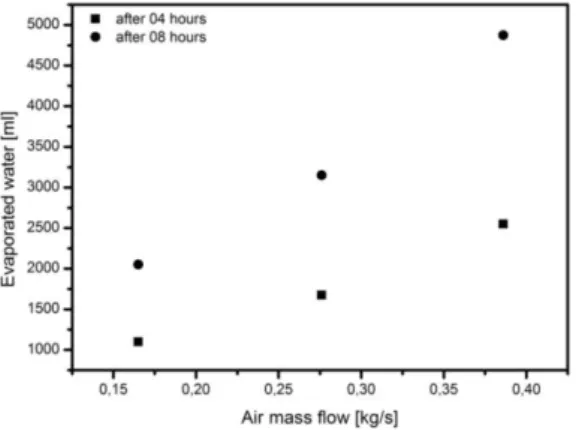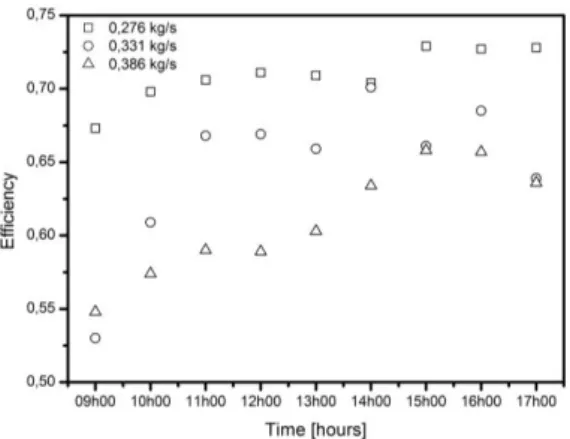ISMRE2018/XXXX-2018 ALGERIA
Experimental performance of a direct evaporative
cooler during summer in Biskra region
Sadam Houcine SELLAM
a, Abdelhafid MOUMMI
a, Adel BENCHABANE
b, Charaf-eddine MEHDID
aand
Abdelmoumen Hakim BEN MACHICHE
ba
Université Mohamed Khider Biskra, Laboratoire de Génie Mécanique (LGM), Faculté des Sciences et de la Technologie, BP 145 Biskra 07000, Algeria
bUniversité Mohamed Khider Biskra, Laboratoire de Génie Energétique et Matériaux (LGEM), Faculté des Sciences et de la
Technologie, BP 145 Biskra 07000, Algeria ………
sh.sellam@univ-biskra.dz
Abstract— This paper presents the experimental effect of
the ambient conditions (relative humidity and temperature), air mass flow and operating time on the thermal performance of direct evaporative cooler (DEC). The set up is installed in Biskra region (34°47’N - 005°43’E) characterized by semi-arid and hot climate. The results showed that the efficiency decreases with increasing the air mass flows for eight hours of continuous functioning when the air mass flow ranged between 0.165 and 0.386 kg/s, and a reduction of the experimental heat exchange rate with decreasing of the ambient temperature and increasing ambient relative humidity.
Keywords— thermal performance, date palm fibers pad, efficiency, evaporation, refresh air, heat exchanged
I. INTRODUCTION
DEC is an air treatment process that uses evaporation of water to cool hot air directly or indirectly. This air conditioning process, as an alternative to conventional air conditioning in hot, arid or semi-arid regions characterized by a summer period.
There are several experimental and numerical studies analysed the effect of operating parameters on the DEC’s thermal performance (1-4).
Malli et al. studied experimentally the thermal performance of two types of cellulosic pads (5090 and 7090) made from corrugated papers. Pressure drop, humidity variation, evaporated water and effectiveness have been investigated for several inlet air velocities. The authors found that overall pressure drop and amount of evaporated water increase by increasing the inlet air velocity and thickness in both types of pads. On the other hand, effectiveness and humidity variation decrease by increasing inlet air velocity
(1).
Recently, Sellam et al. studied experimentally the thermal performance of DEC as a function of the duration operation and air mass flow of DEC in Biskra region. Measurements were taken in continuous operation for 06 months during the summer season. Results showed that the efficiency of this refresh system (DEC) reached 81 % (2), especially for high outside temperatures.
Wei Chen utilized a wet porous cooling plate for building wall. The results showed that with a decreasing in ambient relative humidity and an increasing in ambient temperature,
more cooling of the porous evaporative plate can be supplied for the inside of the room (3).
As numerical study, Igor Kovacevic and Maarten Sourbron proposed a numerical model for a compact direct-contact cross-flow air/water heat exchanger. This numerical model is able to predict the air outlet temperature, with a maximal error of 1.33 % (4).
In this paper, the authors studied the efficiency and heat exchange rate of the DEC experimentally. The set up used date palm fibers as new evaporative refresh pad materials.
II. EXPERIMENTAL METHOD
The direct evaporative cooler (DEC) is installed at the University of Biskra, Algeria (34°47’N - 005°43’E). As described by Sellam et al. (2), This experimental setup consists of a rectangular tunnel in plexi-glass of 04 mm thicknesses and with dimensions of 0.3 x 0.3 m2 and total length of 1.5 m as shown in "Fig. 1". The pads type is date palm fibers ''Fig. 2''. The experiences were carried out with interfaces of 30 mm thicknesses and 0.3x0.3 m2 area. The ambient airflow is driven to the rectangular tunnel by a blower fan. The flow rates were controlled by a speed variator to provide inlet air speeds interval of [1.5 - 4.5 m/s]. Refresh water was sprayed on the top of the refresh pad in order to spray water uniformly and perpendicular to the test section. The header tube has a valve for the control water flow. One pump was used for circulating water from the water collecting tank and header tube. The drainage water was collected in the reservoir and was recirculated by the pump.
Experiments were carried in the period from May 01st to September 30th 2018 for an interval of air mass flow [0.16-0.373kg/s]. The experiments were performed about 09:00 a.m. to 17:00 p.m. for each air mass flow, the temperatures are measured each one hour.
At the start of each test, experimental setup was run for about 30 min, then dry bulb and wet bulb temperatures of air at the inlet and at the outlet were measured using PT100 sensors and recorded using a data logger. The humidity at the inlet and outlet of the pads, temperature of water in the reservoir and water consumption were recorded.
1 blower fan 7 rectangular tunnel 2 speed variator 8 PT100 Sensors 3 data logger 9 date palm fibers pads 4 water collecting tank 10 pump
5 NTC sensor (water temperature) 11 Flowmeter 6 header tube 12 Orifices (humidity) Fig. 1. Description of the experimental set up
Fig. 2. Photograph of date palm fibers pad
III. DEC THERMAL PERFORMANCE
In order to evaluate the performance of the DEC, we often use certain concepts, expressed by:
The experimental heat exchange rate is calculated by the following equation: ( ) ( ) ( i o) c a a a Q mCp T T (1) As we can evaluate the efficiency of DEC is calculated by the following equation:
( ) ( ) ( ) ( ) ( ) i o a a i a w T T T T (2)
IV. RESULTS AND DISCUSSION
''Fig. 3'' showed the evolution of the amount of evaporated water as a function of different air mass flow and operating time. From the figure, it is found that by increasing the air mass flow and operating time the amount of evaporated water increases. It is due to the fact that increasing the air mass flow and operating time leads to increasing the mass transfer coefficient inside the surfaces of palm fiber pads.
''Fig. 4'' indicates the effect of ambient conditions on the efficiency, and experimental heat exchange rate for 0.276 kg/s. it is evident that with increasing the experimental heat exchange rate with increasing the ambient temperature. Moreover, it can be seen that the variation of the efficiency decreases with increasing the ambient relative humidity. This figure shows that ambient relative humidity has an effect on the temperature distribute in DEC system, with a decreasing in ambient relative humidity, the evaporation rate in the surface pad increase.
''Fig. 5'' demonstrated the variation of the efficiency of DEC with air mass flow between 0.276-0.386 kg/s. It is observed that the efficiency decreases with increasing the air mass flows for eight hours of continuous functioning. This is due that the reduction of heat transfer between the air inside the DEC and the surface pad involves a decreasing of the gradient between inlet and outlet temperature, which leads to deteriorating the performance of DEC. as seen with increasing the operating time, the efficiency of direct evaporative cooler increases.
Fig. 3. Effect of air mass flow rate on the evaporated water
Fig. 4. Evolution of efficiency and heat exchanged as function of ambient conditions
Fig. 5. Evolution of the efficiency versus time functioning and air mass flows
V. CONCLUSIONS
The experimental data show that the maximum efficiency occurs in air mass flow 0.276 kg/s for thickness 30 mm and water mass flow 0.2 liter/min. On the other hand the minimum evaporated water (after 8 hours) occurs at minimum air mass flow. Furthermore, we can conclude that the DEC has a higher evaporation rate at the lower ambient relative humidity. The effects of the ambient conditions (relative humidity and temperature) on the cooling characteristic need to be taken into account (3).
ACKNOWLEDGMENT
This study was supported by the Algerian Ministry of Higher Education and Scientific Research as a part of CNEPRU project.
REFERENCES
[1] Malli A, Seyf HR, Layeghi M, Sharifian S, Behravesh H. Investigating the performance of cellulosic evaporative cooling pads. Energy Conversion and Management. 2011;52(7):2598-603. [2] SELLAM SH, MOUMMI A, Hakim A. Rafraichissement de l’Air par
Effet d’Evaporation d’Eau en utilisant la Fibre de Palmier Dattier, Application dans les Zones Arides et Semi-Arides.
[3] Chen W. Thermal analysis on the cooling performance of a wet porous evaporative plate for building. Energy Conversion and Management. 2011;52(5):2217-26.
[4] Kovačević I, Sourbron M. The numerical model for direct evaporative cooler. Applied Thermal Engineering. 2017;113:8-19.
NOMENCLATURE
Cp Specific heat J/(kg . K) ṁ mass flow rate of air kg/s T Temperature °C t Time s
Abbreviations
DEC Direct Evaporative Cooler
Subscripts a Air amb Ambient i Inlet o Outlet w wet

